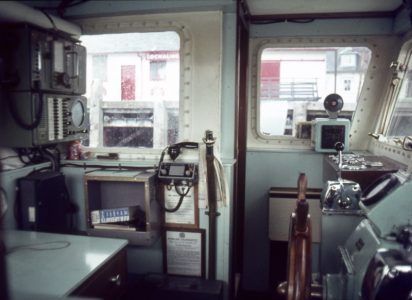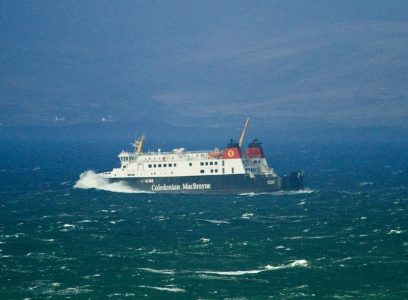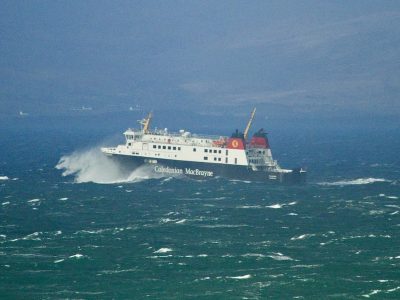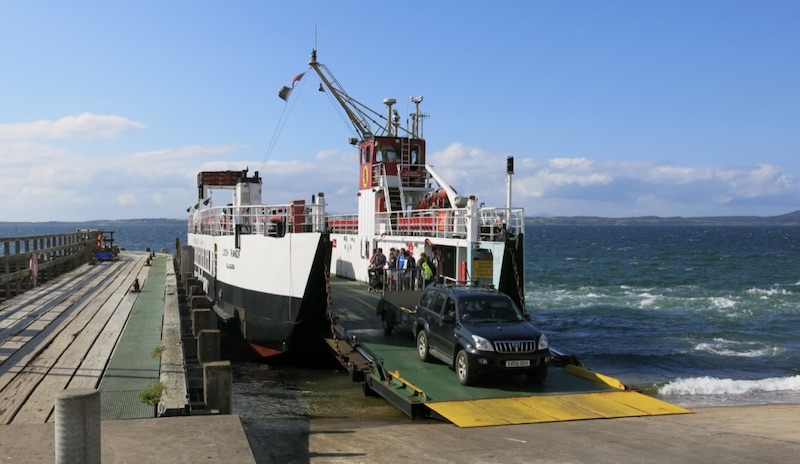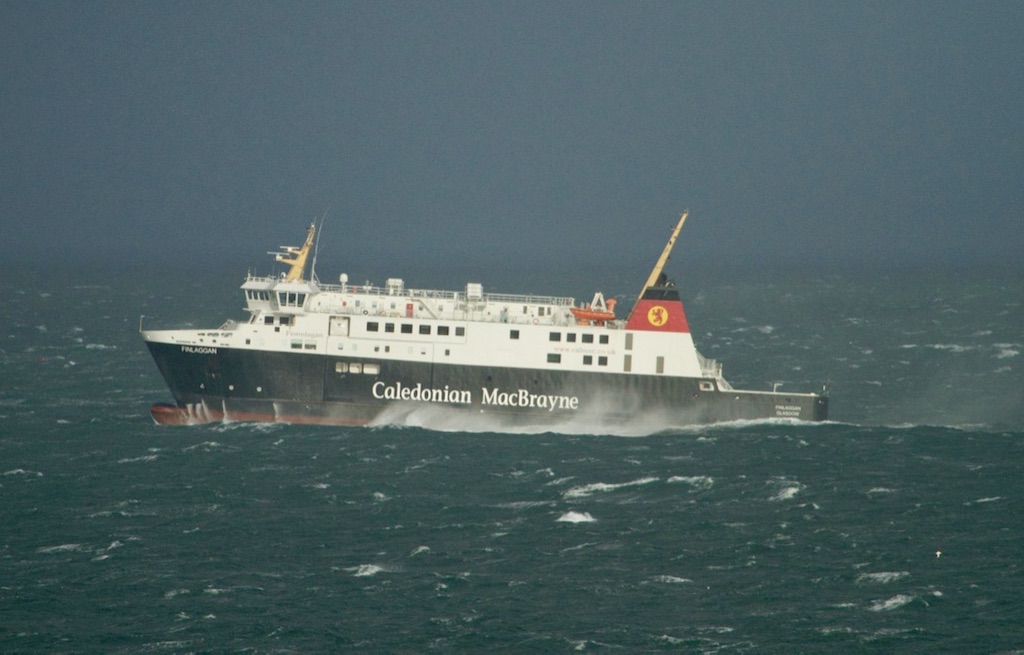
Finlaggan heads into a sou’westerly swell on her way to Islay on 24 January 2018. Copyright John Bannatyne
John Bannatyne, Gigha-based skipper of CalMac ferry Loch Ranza, recently posted a series of graphic photographs of Finlaggan on Facebook, wowing everyone who saw them. In case you missed them, we reproduce them here by courtesy of John. Interview by Andrew Clark.
When Gigha native John Bannatyne was aged two, his mother took him to the north end of the island and photographed him sitting on a rock with Lochiel in the background. It was one of the MacBrayne mail steamer’s final encounters with the local flit-boat before she was withdrawn early in 1970.
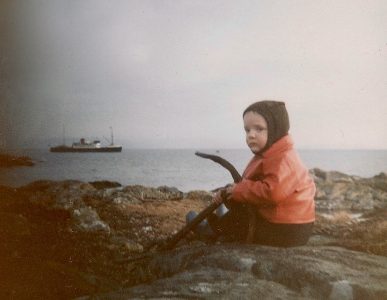 Something about the occasion must have impressed itself on the young islander.
Something about the occasion must have impressed itself on the young islander.
Nearly 50 years later, on 24 January 2018, John was standing not far from that spot, on Carn na sara (‘the watch cairn’), as one of Lochiel’s successors, Finlaggan, ploughed into a sou’westerly swell on her way to Islay. Once again a camera was to hand. Despite the fierce wind, John managed to keep clicking as Finlaggan buried her nose into each wave before heaving up to reveal her bulbous bow. The result was a grandstand set of images, the like of which few photographers can match.
“I keep an eye on the conditions, and if there’s an opportunity to go to the north of the island and get a good picture, I’ll try to do it,” says John. “As often as not it doesn’t work out. That day the conditions were particularly challenging. I had hoped to get Hebridean Isles on an earlier sailing, but the times were all out because of the weather, and she had already gone. Finlaggan was on the delayed 09.40 sailing, leaving Kennacraig around 11.00. I arrived at Carn na sara just in time.” With a touch of pride in his voice, John adds that it was a Gigha man who was Master of Finlaggan that day — Captain Lachlan Wotherspoon.
For anyone wondering how John managed to get such finely focused shots from a distance, he was using a Canon 7D camera with a Canon 100-400 lens, with the telephoto extended to its limit — “a terrific combination for long-distance stuff.” The shutter speed was 1/4000th of a second at ISO 640.
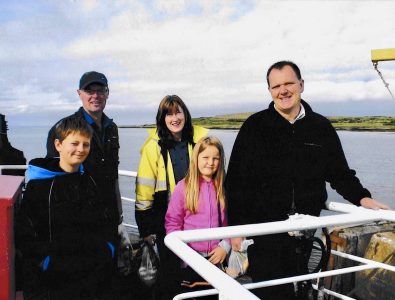
John Bannatyne (right), skipper of Loch Ranza, with motorman Ian Wilson, seaman/purser Jane Clements and his children Ben and Beth
John Bannatyne has been a ferryman at Gigha since 1986. When an advert appeared that year for the job of seaman/purser, he was working off the island, and it was his father who alerted him. For aficionados of west coast shipping, the Gigha ferry may be the Cinderella of Hebridean services, a Kintyre cul de sac, but for John it offered “the chance to come back and live on the island where I grew up.”
The CalMac vessel most frequently on the run in those days was Bruernish, though John also worked on Canna, Morvern, Raasay and Rhum (never Eigg, and Isle of Cumbrae called at Gigha only once, in thick fog in February 1991).
“It was a real education to work on those boats,” he says, referring to the bow-loading ‘Island’ class. “I was able to study the seamanship required of the older skippers.”
He mentions three no longer with us — Graeme MacCulloch, Archie Graham and Ian McKechnie.
“It was never the crossing that posed the problems, always the berthing and manoeuvring” — a comment many a CalMac skipper up and down the west coast would endorse.
“The mainland berth at Tayinloan used to be full of seaweed, which meant that when manoeuvring, you couldn’t use astern power — it was only possible with neutral or ahead. Otherwise you’d choke up the salt water cooling system. These chaps had to get it right first time, every time.”
If seaweed was one of the less welcome signs of the natural world in Bruernish’s orbit, the annual visit of a friendly guillemot could be guaranteed to lift the spirits. “She nested below the emergency fire pump on the deck for around five years in succession, arriving onboard each evening as we made our way to the overnight mooring and departing each morning when we boarded the vessel,” remembers John. “Needless to say none of her eggs ever incubated and eventually she would disappear for the remaining months of the year, only to reappear the following spring. This only stopped when Bruernish departed the service, to be replaced by Loch Ranza on 28 September 1992, leaving our feathered friend with no suitable ‘nest-box’.”
John became a skipper in 1995 — “I started at the bottom rung, and when someone retired, everyone moved up a peg” — and since 2016 has shared the job with Brian Tait, an Orcadian who used to work for Western Ferries. They work one week on, one off, changing over on Tuesday evenings.
The two most regular relief skippers are John MacDonald from Campbeltown and Duncan MacNeill from Tarbert.
Last week John Bannatyne was at Troon for Loch Ranza’s annual overhaul. She operates with a crew of three and “is completely reliable” — which he puts down to “the extreme reliability of simple systems. In the last 10 years the number of times we’ve had technical problems barely runs to double figures.”
Now John’s children — four of them, ranging from age 15 to three — are beginning to show an interest in the ferries. Maybe, in 10 or 20 years, a third-generation Bannatyne will be snapping ships from the north end of Gigha.
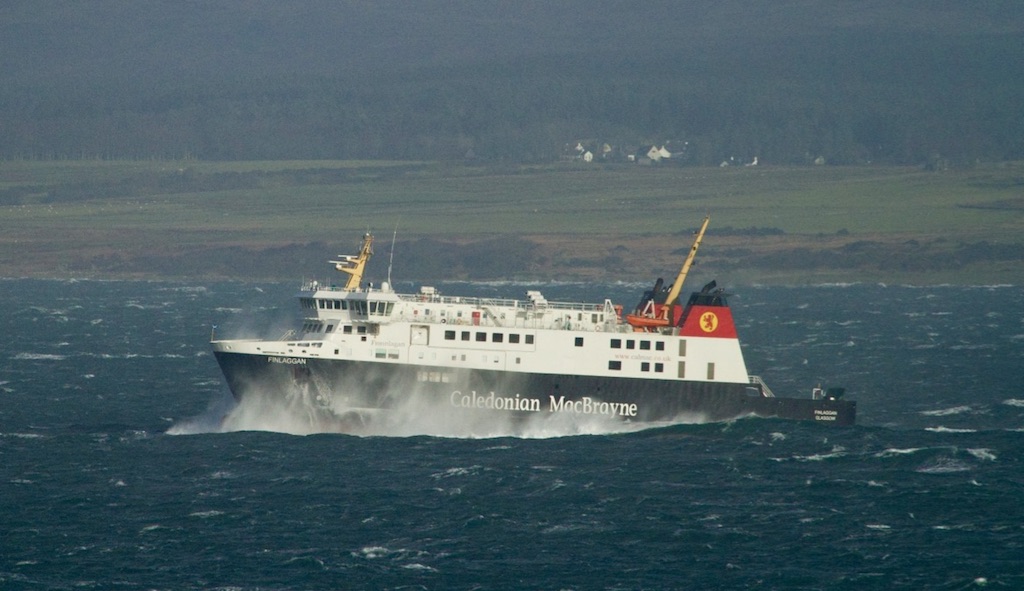
‘That day the conditions were particularly challenging’ — Finlaggan on 24 January 2018. Copyright John Bannatyne

Changeover at Arminish Bay, Gigha, in early February 2018, with Loch Ranza (left) about to depart for overhaul and Loch Linnhe (right) about to take up the run. Looking north, the conditions could not have been more different from the day of the Finlaggan photos. Copyright John Bannatyne
All photos on this website are copyrighted by their respective owners. All rights reserved. Unauthorised use is prohibited.












